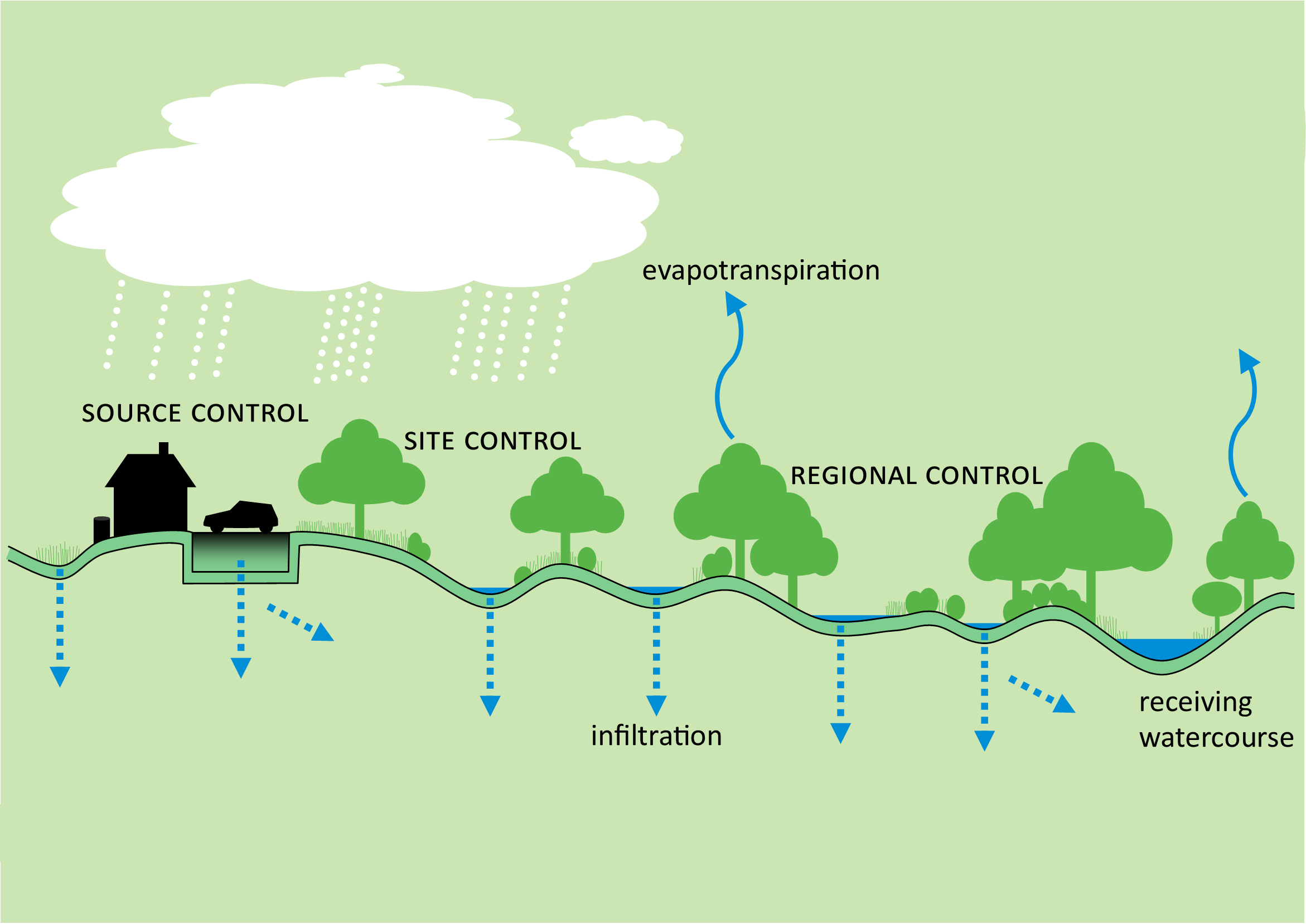Definition and purpose
SuDS is an acronym for Sustainable urban Drainage Systems. SuDS that are based on existing features of a site are the most appropriate method of providing efficient drainage to new developments. However, the use of SuDS may only help to deliver better quality development and amenity improvements if they are designed correctly and fully incorporated into a master plan at the earliest stages.
Good SuDS schemes should combine engineering principles with interesting and innovative landscape design, and this is most successfully achieved at the beginning of the design phase. SuDS require an understanding of how water behaves naturally and how engineered structures can be integrated into an attractive and useful landscape setting. SuDS can provide a creative way to manage rainfall in a way that can actually improve the quality of the built environment.
Key points to consider
Sustainable drainage is a departure from the traditional approach to draining sites. There are some key principles that influence the planning and design process enabling SuDS to mimic natural drainage by:
- storing runoff and releasing it slowly (attenuation)
- harvesting and using the rain close to where it falls
- allowing water to soak into the ground (infiltration)
- slowly transporting (conveying) water on the surface
- filtering out pollutants
- allowing sediments to settle out by controlling the flow of the water
Creating reliable SuDS schemes
The creation and design of effective schemes calls for the inclusion of:
- SuDS on the surface: where possible, runoff from developments should be managed on the surface. This enables the performance of SuDS to be more easily inspected and managed with pollution incidents and potential flood risks being visible.
- The SuDS management train: this is a series of step-by-step recommendations for designing SuDS schemes, and it starts with prevention (preventing runoff by reducing impermeable areas), or good housekeeping measures for reducing pollution; and progresses through local source controls to larger downstream site and regional controls.
- Source control: managing water runoff as close as possible to where it falls as rain. Runoff need not pass through all the stages in the management train. It could flow straight to a site control, but as a general principle it is better to deal with runoff locally, returning the water to the natural drainage system as near to the source as possible.
- Sub-catchments: the management train concept promotes division of the area to be drained into sub-catchments with different drainage characteristics and land uses, each with its own drainage strategy.

There are many different SuDS components, and those used will often depend on the specific characteristics of the site where the SuDS are to be built and the effect the designer is trying to achieve.
Groups of SuDS components
SuDS components can be split into seven separate groups that take up different levels of land and have different effects on the landscape. These are:
- source control: includes green roofs, rainwater harvesting and permeable pavements, i.e. all components that manage runoff as close to the point where it falls as rain as possible
- filtration: includes filter strips, filter drains or trenches that are often gravel filled and used next to roads, and surface and subsurface sand filters
- infiltration: includes soakaways and trenches designed to allow water to seep slowly into the ground
- detention: detention basins are often designed as a dry landscaped area that can be used to detain large volumes of stormwater when required, and also subsurface storage such as geocellular systems
- retention: includes retention ponds (similar to traditional ponds) that are designed with water treatment and runoff volumes in mind
- wetlands: includes wetlands that are often designed to treat water and provide increased biodiversity. Due to the sensitivity of plants used in wetlands, often they need protecting with other SuDS further upstream, which may remove heavy pollutant loads
- open channels: includes swales (shallow grass channels), which convey water as well as provide some infiltration capacity, and other harder engineered open channels such as canals and rills
The practical implications for planning officers and applicants
There are a number of publications available to support planning officers and applicants in the successful development of SuDS schemes. The non-statutory technical standards for the design, maintenance and operation of sustainable drainage systems to drain surface water is published by Defra. The standards apply to systems that drain surface water from housing, non-residential or mixed use developments for the lifetime of the developments. The non-statutory technical standards are to be used in conjunction with the National Planning Policy Framework.
The SuDS Manual (CIRIA publication C753) guides the applicant through the design process and can be referred to by the planning officers checking design and calculations to ensure that sustainable drainage principles have been applied.
The Flood and Water Management Act 2010 requires Local Planning Authorities to adopt and maintain approved SuDS which are functioning properly and serve more than one property. North Yorkshire Council operate as the Lead Local Flood Authority for the Craven area.
Relevant Craven local plan policies and guidance
Green Infrastructure & Biodiversity SPD, Flood Risk & Water Management SPD